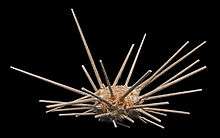Cidaris cidaris
| Cidaris cidaris | |
|---|---|
 | |
| Cidaris cidaris Dried specimen | |
| Scientific classification | |
| Kingdom: | Animalia |
| Phylum: | Echinodermata |
| Class: | Echinoidea |
| Order: | Cidaroida |
| Family: | Cidaridae |
| Genus: | Cidaris |
| Species: | C. cidaris |
| Binomial name | |
| Cidaris cidaris (Linnaeus, 1758)[1] | |
| Synonyms[1] | |
| |
Cidaris cidaris is a species of sea urchin commonly known as the long-spine slate pen sea urchin. It is found in deep water in the eastern Atlantic Ocean and the Mediterranean Sea.
Description
Cidaris cidaris has a small central test from which project a number of long, blunt, widely separated primary spines and a dense covering of short secondary spines. The primaries are pale grey, tipped with green and the secondaries are pale green. The test has a diameter of 7 cm (2.8 in) to 8 cm (3.1 in) and the spines are twice as long as this.[2] The sea urchin often has bits of algae, sponge or other organisms adhering to the spines.[2]
Distribution
Cidaris cidaris is found in the eastern Atlantic Ocean and the Mediterranean Sea in deep water on coral, rock and gravel bottoms. Its range extends from Cape Verde, the Azores and the Canary Islands northwards to the Faroe Islands and Norway. It is also found on knolls and seamounts[1] at depths down to about 1,800 metres (5,900 ft).[3]
Biology
Cidaris cidaris feeds on sponges, sea fans and algae.[2]
Cidaris cidaris is one of a number of species of sea urchin that can suffer from bald sea urchin disease.[4]
See also
References
- 1 2 3 Kroh, Andreas (2012). "Cidaris cidaris (Linnaeus, 1758)". World Register of Marine Species. Retrieved 2013-04-25.
- 1 2 3 "Cidaris cidaris (Linnaeus, 1758)" (in Spanish). asturnatura.com. Retrieved 25 April 2013.
- ↑ Tyler, P. A.; Gage, J. D. (1984). "The reproductive biology of echinothuriid and cidarid sea urchins from the deep sea (Rockall Trough, North-East Atlantic Ocean)". Marine Biology. 80: 63–74. doi:10.1007/BF00393129.
- ↑ Jangoux, Michel (1987). "Diseases of Echinodermata: Diseases caused by micro-organisms" (PDF). Diseases of Aquatic Organisms. 2: 147–162. doi:10.3354/dao002147.